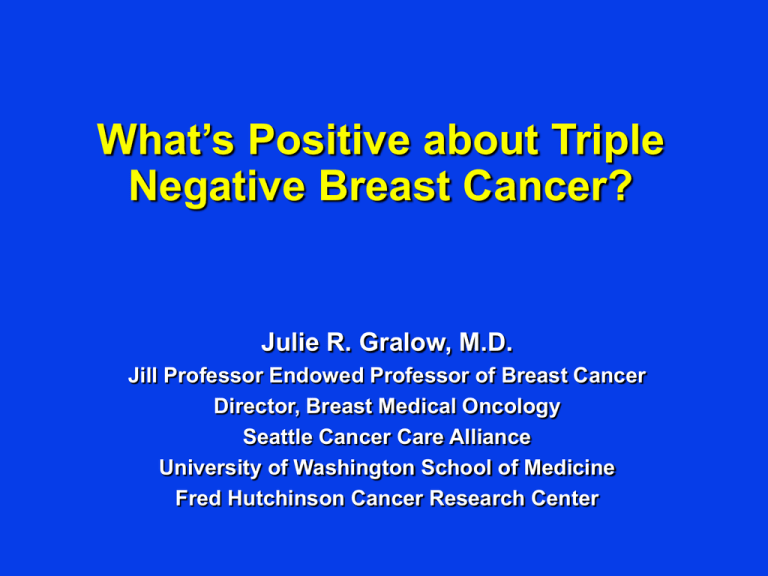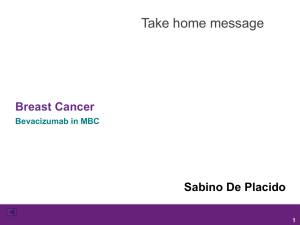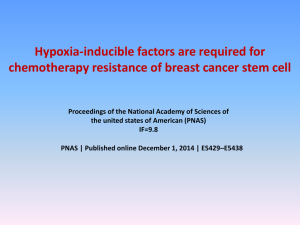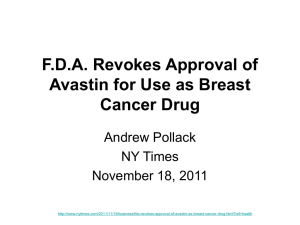
What’s Positive about Triple
Negative Breast Cancer?
Julie R. Gralow, M.D.
Jill Professor Endowed Professor of Breast Cancer
Director, Breast Medical Oncology
Seattle Cancer Care Alliance
University of Washington School of Medicine
Fred Hutchinson Cancer Research Center
Breast Cancer: Classic Prognostic
and Predictive Factors
HER-2 +
20-25% of
Breast Cancer
Estrogen
Receptor (ER) +
75% of Breast
Cancer
Triple Negative Breast Cancer
•
•
•
•
•
No expression of ER, PR, ER2
15% of breast cancers
Aggressive, higher recurrence rates
Chemotherapy is currently main treatment option
More common in:
– Young women
– African Americans
– Hispanics
– BRCA1+ (80%)
Racial Distribution of Triple Negative
Breast Cancer
Stead LA, et al, Breast Cancer Research 11:R18, 2009
Timing of Recurrence in Triple Negative
Breast Cancer vs. Other Subtypes
Dent et al. Clin Can Res 2007; 13: 4429
Gene Expression Profiling in
Breast Cancer
• Over the last decade, gene expression profiling has
given us insights into the biological complexity of
breast tumors
• Clinically applicable gene expression-based assays
have been and are being developed for prediction of
prognosis and/or treatment benefit
Molecular Classification of Breast Cancer:
Breast Cancer is NOT One Disease!
The Cancer Genome Atlas Network. Nature 490, 2012
“Heat Map”
Red dots:
Genes are
“turned
up” in
cancer
cells
compared
to normal
cells
Luminal
A
Normal
Luminal HER-2+ Basal
Breast–like
B
Individual
genes
Individual patients
Basal Subtype
• Low expression of luminal and HER2 gene clusters
– Typically ER-, PR-, and HER-2-negative, but up to 30 percent
discordance
• High expression of proliferation cluster genes, virtually always
high grade, widespread genomic instability
– High expression of EGFR and unique basal cluster genes
(basal epithelial cytokeratins 5, 14, and 17)
– p53 mutations common
– Other receptors and pathways can be altered (c-kit, c-met,
RAS-MAPK, mTOR/PI3K)
• Strong association with cancers in BRCA1 mutation carriers
(over 80 percent basal-like)
• Associated with DNA repair defects
– PARP1 commonly increased
Clinically Available Genomic Assays in
Breast Cancer
Genomic Health Oncotype Dx 21-Gene
Recurrence Score Assay
•OncotypeDX and
Mammaprint provide
prognostic information
in early breast cancer
•OncotypeDX provides
predictive information of
benefit from adjuvant
chemotherapy in ERpositive disease
Agendia Mammaprint 70-Gene Prognostic Signature
Assay
PAM50 Breast Cancer
Intrinsic Classifier Assay
• PAM50 classifier identifies the four major biologic
subtypes of breast cancer referred to as Luminal A,
Luminal B, HER2-enriched, and Basal-like
• Measures 50 classifier genes and 5 control genes
through RT-qPCR
• Investigational in US
• Clinical validation studies ongoing
Not all Triple Negative Breast Cancers
are Basal Subtype, and Not all Basal
Breast Cancers are Triple Negative
Prat A et al, Oncologist 2013 epub ahead of print
Clinical status (by standard pathology testing): Triple Negative
Subtype status (by genomic profiling): Basal
Triple Negative Breast Cancer: Subtypes
and Therapeutic Targets
Lehmann B, JCI 2011; Pietenpol J. SABCS 2012
Genomic Profiling of TNBC: 6 Subtypes Identified!
Analysis of 21
public data sets
Identified 587
TNBCs
386 in training set
201 in validation
set
Differential sensitivity of TNBC
cell lines to targeted agents due to
distinct expression patterns,
expression of key mutations in
oncogenes and tumor
suppressors
Treatment Approaches for Triple
Negative Breast Cancer
• Specific chemotherapy agents (e.g.
platinums)
• Anti-angiogenics (blood vessel blockers)
• Poly ADP ribose polymerase (PARP)
inhibitors
Preoperative Chemotherapy with
Platinum Compounds: Phase II Trials
Garber
CDDP → Surg
N = 28
Ryan
CDDP/BEV → Surg
N = 51
Torrisi
ECF → P → Surg
N = 30
80
Gronwald
CDDP → Surg
N = 25
72
% pCR
60
40
40
22
15
20
0
Pt Characteristics
Triple
Negative
Triple
Negative
Triple
Negative
BRCA-1
Mutation
1. Garber JE, et al. Breast Cancer Res Treat. 2006;100(Suppl 1): Abstract 3074. 2. Ryan PD, et al. J Clin Oncol.
2009;27(15S): Abstract 551. 3. Torrisi R, et al. Cancer Chemother Pharmacol. 2008;62(4):667-672. 4. Gronwald J, et al. J
Clin Oncol. 2009;27(15S): Abstract 502.
TBCRC 009: Phase II Study of Cisplatin or
Carboplatin in Metastatic TNBC
Isakoff SJ et al, ASCO 2011 abstract # 1025
• Patients: 86 metastatic TNBC
• Treatment: Randomized to cisplatin or carboplatin
• Results:
– Response Rate 30% overall
» Cisplatin 37%
» Carboplatin 23%
– 1st line RR 32%, 2nd line 20%
• Conclusion: Both active and well-tolerated
– Evaluating p63/73 for prediction of response
Phase III Trial of Eribulin vs Capecitabine for
Metastatic Breast Cancer
Kaufman P et al, SABCS 2012 Abstract # S6-6
• Eribulin has demonstrated survival benefit in heavily pre-treated
metastatic breast cancer
• Capecitabine approved for treatment of metastatic breast cancer
following exposure to anthracycline/taxane
Co-primary endpoint
• OS and PFS
Line of therapy
•20% 1st line
•50% 2nd line
•30% > 3rd line
Phase III Trial of Eribulin vs Capecitabine for
Metastatic Breast Cancer
Kaufman P et al, SABCS 2012 Abstract # S6-6
Overall survival by receptor status
• No significant difference between eribulin and capecitabine
• Exploratory analysis suggests possible increased benefit for eribulin
in certain subsets (ER-, TNBC)
– TNBC: Overall survival 14.4 months eribulin, 9.4 months
capecitabine
Angiogenesis Inhibition: Agents
Targeting the VEGF Pathway
BLOOD VESSEL CELL
VEGF
Receptor
Bevacizumab
(Avastin) Anti-VEGF
Antibody: binds to
VEGF and blocks
tumor blood vessel
growth
VEGF
CANCER CELL
Other VEGF/VEGFR
inhibitors:
sunitinib
sorafenib
axitinib
pazopanib
1st-Line Bevacizumab
E2100: Paclitaxel +/- Bevacizumab in
Stage IV Breast Cancer
Miller KD et al, NEJM 2007
Eligibility:
- No prior chemo
for mets
-Adjuvant taxane if
>12 mos.
-HER-2+ only if
prior trastuzumab
Accrual: 685
R
A
N
D
O
M
I
Z
E
Paclitaxel + bevacizumab
Paclitaxel
28-day cycle:
Paclitaxel 90 mg/m2 d1, 8, and 15
Bevacizumab 10 mg/kg d1 and 15
Paclitaxel +/- Bevacizumab in Metastatic
Breast Cancer
Miller KD et al, NEJM 357:2666-76, 2007
Paclitaxel alone
30
Paclitaxel
+ Bevacizumab
40
25
35
30
25
38%
20
%
15
10
5
16%
0
Response
m
o
n
t
h
s
28
20
25
15
10
5
11
6
0
TTP
Survival
E2100: Paclitaxel +/- Bevacizumab in Stage
IV Breast Cancer
Miller KD et al, NEJM 2007
•Toxicities (grade 3,4)
Paclitaxel
HTN
2%
Thrombosis 4%
Bleeding
0%
Proteinuria
0%
Paclitaxel + Bev
15%
2%
2%
2%
Accelerated FDA approval in 2008
p<0.001
p=0.02
p=0.002
FDA Revoked Approval of
Bevacizumab in Breast Cancer
• FDA removed metastatic breast cancer from
bevacizumab label
– No survival benefit
– Toxic
• Biologic reality?
• Rebound effect?
• Lack of targeting to appropriate population?
– Which patients?
– Which tumors?
2nd-Line Bevacizumab
Phase III RIBBON 2 Trial of Chemo/Bevacizumab in
2nd-line HER2-Negative Metastatic Breast Cancer
Brufsky A et al, J Clin Oncol 2011
Inclusion criteria:
• 1 prior
chemotherapy
• HER2 negative
R
A
N
D
O
M
I
Z
E
(n = 684)
Chemotherapy (taxane*,
gemcitabine, vinorelbine, or
capecitabine)
Bevacizumab 10 mg/kg q 2
weeks or 15 mg/kg q 3 weeks
PD
2:1
Chemotherapy (taxane*,
gemcitabine, vinorelbine, or
capecitabine)
Placebo q 2 weeks or q 3
weeks
PD
* Taxane allowed: q 3weekly docetaxel,
paclitaxel, or albumin-bound paclitaxel
RIBBON 2: Efficacy
Chemotherapy/
Placebo
Chemotherapy/
Bevacizumab
30%
39.5%
Overall Response Rate
P = 0.0193
5.1 months
Median Progression-Free
Survival
HR 0.78 (95% CI, 0.64-0.93); P = 0.0072
16.4 months
Median Overall Survival
(Interim)
7.2 months
18 months
HR 0.90 (95% CI, 0.71-1.14); P = 0.3741
•Response rate, PFS higher with bevacizumab; OS not statistically
different
RIBBON 2: Progression Free Survival
in Triple Negative Subgroup
Brufsky A et al, Breast Cancer Res Treatment 2012
Estimated probability
1.0
PFS
Events, n (%)
0.8
Median, months
HR
0.6
BEV + CT
(N = 112)
94 (84)
PLA + CT
(N = 47)
42 (89)
6.0
2.7
0.494
Log-rank test
p = 0.0006
0.4
0.2
2.7
0.0
0
6.0
5
10
15
Time (months)
20
25
RIBBON 2: Interim Overall Survival in
Triple Negative Subgroup
Brufsky A et al, Breast Cancer Res Treatment 2012
OS
Events, n (%)
1.0
Estimated probability
Median, months
0.8
BEV + CT
(N = 112)
52 (46)
PLA + CT
(N = 47)
29 (62)
17.9
12.6
HR
0.624
Log-rank test
p = 0.0534
0.6
0.4
0.2
12.6
17.9
0.0
0
5
10
15
Time (months)
20
25
30
BEATRICE: Phase III Trial of Adjuvant
Bevacizumab in Triple Negative Breast Cancer
Cameron D et al, SABCS 2012, Abstract # S6-5
• Eligibility
– Resected invasive breast
cancer
– Negative for ER, PR,
HER2 (centrally
confirmed)
• N=2,591
– 63% lymph node negative
Primary endpoint: invasive
disease-free survival
Investigator’s choice
of standard chemo
(4-8 cycles)
Observation
Investigator’s choice
of standard chemo
(4-8 cycles)
BEV (5mg/kg/wk
equivalent)
BEV monotherapy
(total duration 1 yr)
• Chemotherapy options
• Taxane based > 4 cycles
• Anthracyclline based >4
cycles
• Anthracycline + Taxane
(3-4 cycles each)
BEATRICE: Phase III Trial of Adjuvant
Bevacizumab in Triple Negative Breast Cancer
Primary Endpoint: IDFS
Interim OS (59% of events)
No improvement in DFS or OS for
addition of bevacizumab
BEATRICE: Phase III Trial of Adjuvant
Bevacizumab in Triple Negative Breast Cancer
• Disappointing
• 1st randomized Phase III adjuvant trial
specifically for triple negative population
• 3 year survival better than anticipated
• No significant improvement in DFS/OS with
addition of bevacizumab
• Adverse event profile consistent with that
previously seen
Recently Reported Preoperative Trials
of Bevacizumab in Breast Cancer
• NSABP B-40 (Bear H et al) NEJM 2012
– Preop anthracycline/taxane chemotherapy +/bevacizumab
– Improved pathologic Complete Response (pCR) with
bevacizumab: 28.4% vs 34.5%, p = 0.027
• Geparquinto (Von Mickwitz G et al) NEJM 2012
– Preop anthracycline/taxane chemotherapy +/bevacizumab
– Overall (HER2-): pCR 15% vs 17.5% p = ns
– Triple negative subset: pCR 27.8% (no bev) vs 36.4%
(with bev) p = 0.21
Will this translate into improved DFS and OS in the
adjuvant trials? Possible reason for optimism?
The Human Epidermal Growth
Factor Family of Receptors
•Lapatinib
HER1
EGFR
HER2
HER3
HER4
Tumor Cell
•Erlotinib
•Gefitinib
•Cetuximab
•Trastuzumab
•Pertuzumab
EGFR Targeted Therapy in
Unselected Metastatic Breast Cancer
n
RR
CB
TTP
Gefitinib
Robertson (2003)
Baselga (2003)
Albain (2002)
33
32
63
7%
0%
2%
30%
6%
5%
?
8 wks
8 wks
Erlotinib
Winer (2002)
69
3%
6%
6 wks
• Conclusions:
– Minimal clinical activity in heavily pretreated,
unselected breast cancer patients
– Pharmacodynamic results were seen: EGFR signaling
pathway is affected in tumor and skin
– Possible role in “triple negative” population?
TBCRC 001: Randomized Phase II Study of
Cetuximab in Combination with Carboplatin in
Stage IV TNBC
Carey LA et al, J Clin Oncol 30, 2012
Eligibility:
-Metastatic
TNBC
102 patients
R
A
N
D
O
M
I
Z
E
Carboplatin + Cetuximab
Cetuximab
PD
Cetuximab +
Carboplatin
TBCRC 001: Randomized Phase II Study of
Cetuximab in Combination with Carboplatin in
Stage IV TNBC
Carey LA et al, J Clin Oncol 30, 2012
Cetuxumab
Cetux
Cetux +
Carbo
Cetux + Carbo
0
0
1.4%
6%
17%
15%
Stable Disease
16%
25%
23%
Progressive
Disease
77%
50%
52%
6%
17%
17%
10%
25%
31%
Complete
Response
Partial Response
Overall Response
Clinical Benefit
Rate
TBCRC 001: Randomized Phase II Study of
Cetuximab in Combination with Carboplatin in
Stage IV TNBC
Carey LA et al, J Clin Oncol 30, 2012
•Despite strong preclinical data, combination
cetuximab plus carboplatin in metastatic TNBC
produced responses in fewer than 20% of patients
•EGFR pathway analysis showed that most TNBCs
involved activation
•However, cetuximab blocked expression of the
EGFR pathway in only a minority, suggesting that
most had alternate mechanisms for pathway
activation
Ongoing Study at UW: Combined Targeted Therapies for
TNBC: Phase II Trial of Weekly Nab-Paclitaxel and
Bevacizumab Followed by Maintenance Bevacizumab and
Erlotinib
PI: J Specht
Locally recurrent or metastatic ER/PR/HER2 negative
breast cancer; >6 mos from weekly paclitaxel (n=63)
Nab-paclitaxel 100 mg/m2 IV Qwk x 24 +
Bevacizumab 10 mg/kg IV Q2wk x 8
CR, PR, SD
Bevacizumab 10 mg/kg IV Q2wk + Erlotinib 150 mg PO daily
Primary objective: PFS
Secondary objectives: RR, OS, Safety, EGFR, SPARC expression in
primary tumor, CTC, CEC
PARP as a Target for Therapy
• PARP
– Enzyme with role in DNA repair
– Increased levels in triple negative breast cancer
» Allows cancer cells to be more resistant to
chemotherapy and radiation therapy effects
– Needed for survival of BRCA-deficient cells
PARP is an Important Enzyme in DNA
Repair of Normal Cells as Well as Cancer
Cells
Environmental factors
(UV, radiation, chemicals)
DNA DAMAGE
Normal physiology
Cell Death
(DNA replication)
Chemotherapy, Radiotherapy
Replication Lesions
Single Strand Breaks
DNA REPAIR PATHWAYS
• Base excision repair
• PARP1
• Base excision repair
• PARP1
Double Strand Breaks
• Homologous recombination
• BRCA1/BRCA2
DNA Adducts/Base Damage
• Base excision repair
• PARP1
PARP Inhibitors as Therapy in Breast
Cancer
• PARP inhibitors
– Potentiate effects of chemotherapy-induced DNA
damage
– Single agent activity in BRCA1/2 deficient tumors
– Currently being evaluated in clinical trials
• PARP inhibitors with reported clinical data to date:
– Iniparib (BSI-201)
– Veliparib (ABT-888)
– Olaparib (AZD 2281)
Oral PARP Inhibitor Olaparib in BRCAdeficient Advanced Breast Cancer
Tutt A et al, ASCO 2009, abstract # 501
• Patients: BRCA1/ BRCA2 + advanced, chemotherapy
refractory breast cancer
• Treatment:
–Cohort 1: olaparib 400 mg po BID (27 patients)
–Cohort 2: olaparib 100 mg po BID (27 patients)
• Results:
– Objective response rate 41%
– Median PFS: 5.7 months
– Rare grade 3 nausea, fatigue, vomiting
Randomized Phase II vs Phase III Trial Results
Gemcitabine/Carboplatin +/- Iniparib in Triple
Negative Metastatic Breast Cancer
O’Shaughnessy et al, NEJM 2011 and ASCO 2011, abstract 1007
Chemo alone
Chemo + PARP inhibitor
P=0.027
P=0.28
12
14
12
m 10
o
8
n
6
t
4
h
s 2
12.2
6.9
11.1
10
P=0.005
7.7
3.3
m
8
o
n 6
t 4
h 2
s
4.1
11.8
5.1
0
0
TTP
Survival
TTP
Survival
Randomized Phase III study
Far less impressive
Iniparib originally thought to be PARP inhibitor,
now uncertain
Randomized Phase II study
UW/SCCA Phase I Trial of Cisplatin/Vinorelbine
with PARP Inhibitor ABT-888 (Veliparib) in
Metastatic Breast Cancer
Rodler E et al, SABCS 2011, abstract P1-17-04
Patients with
metastatic TNBC
and/or BRCA
mutation
associated
breast cancer
Cisplatin 75 mg/m2
IV Day 1
Vinorelbine 25
mg/m2 Days 1,8
Veliparib Days 1-14
Dose escalation
every 21 days
UW/SCCA Phase I Trial of Cisplatin/Vinorelbine
with ABT-888 (Veliparib)
Maximum Tumor Response (%) from Baseline
• 36 patients
enrolled to
date
• Currently at
dose level 7 of
veliparib
Triple Negative Breast Cancer is
a Highly Diverse Group of Cancers
6 subtypes of TNBC identified by gene expression
array!
Lehmann BD, et al. J Clin Invest 121:2750-67, 2011
6 Types of Triple Negative Breast
Cancer
• Basal-like 1 and 2 (BL1, BL2)
– High expression of cell cycle and DNA response
genes
– More responsive to platinum chemotherapy
• Immunomodulatory (IM)
• Mesenchymal (M) and Mesenchymal-stem Like (MSL)
– Enriched for genes associated with epilthelialmesenchymal transition
– Responsive to mTOR, PI3K, abl-src pathway drugs
• Luminal Androgen Receptor (LAR)
– Sensitive to androgen receptor drugs
TNBC LAR Subtype
Not Yet Reported TBCRC 011: Targeting
Androgen Receptor for the Treatment of
AR+/ER-/PR- Metastatic Breast Cancer
Gulcap A et al, ASCO 2011, abstract # 122
• 10-20% of TNBC are Androgen Receptor Positive
• Drugs targeting AR are typically used in treating
prostate cancer
– Bicalutamide (Casodex)
– Enzalutamide (Xtandi)
• TBCRC 011: Treatment with bicalutamide
• Study: 230 TNBC patients tested, 27 AR+
– No results to date
Claudin
Basal
-low
HER2
Basal
Claudin-low Subtype
Luminal
Proliferation
•5-10% of tumors
•Typically ER-, PR-, HER2•Low expression of cellcell junction proteins
•Lymphocyte infiltrates
•Stem cell + EMT features
TNBC M/MSL and Claudin-low Subtypes
Metaplastic Breast Cancer
• Subtype of triple negative breast cancer
– Rare, but increasing incidence
• Distinct subtype by molecular profiling
– Claudin-low
– Enriched for epithelial-to-mesenchymal transition
(EMT) markers
– ~50% of tumors have PI3K mutations or loss in PTEN
– Increased VEGF production
• Chemorefractory
– <10% pCR rate with neoadjuvant chemotherapy
– Little data regarding response in metastatic setting
DAT in Advanced Cancers Cancer
Moroney J et al, Clin Cancer Res 18, 2012
• 136 patients with advanced cancer
– 29 breast cancer (12 metaplastic)
• Regimen
– Liposomal doxorubicin (Doxil) 30mg/m2 IV every 3 weeks
– Bevacizumab (Avastin) 15mg/kg IV every 3 weeks
– Temsirolimus (Torisel) 25mg IV weekly
• Results
– Response in metaplastic breast cancer: 5/12 (42%)
TNBC M/MSL and Claudin-low Subtypes
Proposed SWOG Clinical Trial: DAT for
Metaplastic Triple Negative Breast Cancer
PI: S Moulder
• Triple negative, metastatic breast cancer
– High grade metaplastic, spindle cell, or
myoepithelial histology
– Vimentin positive
– ‘Claudin-low’ or Mesenchymal-like tumors by
profiling
• Regimen: DAT vs liposomal doxorubicin
– Liposomal doxorubicin (Doxil) 30mg/m2 IV every 3
weeks
– Bevacizumab (Avastin) 15mg/kg IV every 3 weeks
– Temsirolimus (Torisel) 25mg IV weekly
Molecular Characterization of Residual Triple
Negative Breast Cancer after Preoperative
Chemotherapy
Balko JM et al, SABCS 2012 Abstract # S3-6
114 clinically-defined TNBC
patients with residual
disease after preop chemo
Immunohistochemistry
Ki67, ER, PR, HER2, AR
112/114
Nanostring digital
expression analysis
450 genes
89/114
Next generation
sequencing
182 oncogenes and tumor
suppressors
Molecular Characterization of Residual Triple
Negative Breast Cancer after Preoperative
Chemotherapy
Balko JM et al, SABCS 2012 Abstract # S3-6
No. of samples with aberrations
Clinically Targetable Pathways in TNBC
PI3K/mTOR
inhibitors
DNA repairtargeting
agents
RAF/MEK
inhibitors
Cell cycle/
mitotic spindle
inhibitors
Targeted RTK
inhibitors
These data show that TNBC after preoperative chemotherapy is
heterogeneous and has multiple alterations that are targetable with
existing drugs in development
Treatment with Histone Deacetylase Inhibitors
Creates ‘BRCAness’ and Sensitizes Triple
Negative Breast Cancer Cells to PARP Inhibitors
and Cisplatin
Bhalla KN et al, SABCS 2012 Abstract # S3-7
•
Supports evaluation of HDAC inhibitors
with PARP inhibitors and cisplatin in
TNBC
Synergism data
1.5
veliparib + vorinostat
1.0
CI
Methods:
– Used human triple negative cell lines
» BRCA-mutant (SUM159PT)
» BRCA non-mutant (MDA-MB-231, HCC1937)
– Treated with HDACi (vorinostat), PARPi
(veliparib), & cisplatin
Results:
– Vorinostat synergistically enhanced PARPi and
cisplatin-induced induced DNA strand breaks
and apoptosis
– Synergistic inhibition in TNBC cells (CIs <1.0)
0.5
HCC1937
SUM159PT
0
0
0.2
0.4
0.6
0.8
Fractional Effect
1.0
1.0
HCC1937
0.8
CI
•
0.6
0.4
MDA-MB-231
0.2
cisplatin + vorinostat
0
0
0.2
0.4
0.6
Fractional Effect
0.8
1.0
Triple-Negative Tumor Conclusions
1.
Triple-negative breast cancers are a
heterogeneous group primarily composed of
Basal-like breast tumors
2.
Claudin-low tumors are also a major constituent
of Triple-negative cancers
3.
Chemotherapy benefit is typically high, although
subsets have little chemo benefit
4.
Many biologically targeted agents are being
tested on this group including PARP inhibitors,
angiogenesis inhibitors, HER1/EGFR and
mTOR/PI3K pathway inhibitors
Treatment of Triple Negative Breast
Cancer: The Future is Looking Up!








